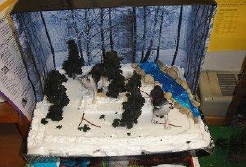Grade Level: 2nd or 3rd
Content area: Life Sciences
Standard identifiers: 2-LS2-1; 3-LS3-1
Objectives: Students will:
- Demonstrate understanding of ecosystems and biomes by:
- Watching one or two videos to introduce them to various ecosystems and biomes
- Independently researching one ecosystem or biome
- Creating a diorama to reflect their research
- Present a short dialogue on what they learned about the ecosystem or biome they researched
Materials and Resources:
Assessment (informal):
- Students research an ecosystem or biome, create a diorama to show the flora and fauna of the ecosystem or biome, and deliver a short oral presentation about what they learned through the project.
Strategies for English Language Learners and Learners with Special Needs:
- Have students do research in their native language.
- Assign students an ecosystem or biome and provide accessible, appropriate resources.
- Introduce key vocabulary before watching videos.

Instructional Sequence:
Introduction and explanation to students about the purpose of the lesson (5 minutes)
- Ask students to describe the weather where they are, for that day and in general. Explain that our weather, hot dry summers and mild wet winters, are a characteristic of Mediterranean climates. You can show them the map of Mediterranean climates found on the MVC’s Virtual Learning Module #3: Stay “Safe at Home” in a Mediterranean Climate Ecosystem webpage. Explain that there are several types of ecosystems in the world, and that you will learn more about them by doing a project.
Monitoring for student learning/understanding:
- Make sure students are using correct punctuation (commas and periods), spelling and capitalization.
Teacher modeling (15-25 minutes)
- Watch one or both of the videos about ecosystems on the MVC’s Virtual Learning Module #3: Stay “Safe at Home” in a Mediterranean Climate Ecosystem webpage (Ecosystems for Kids and Biomes of the World for Children). Here is a video for Spanish speakers. Have students think about what ecosystem or biome they find most fascinating and would want to research further.
Practice (independent) (15 minutes to explain the project; due date is teacher’s choice)
- Provide the directions and rubric for students to complete their ecosystem/biome diorama. Give them ideas of where they can do their own research on their ecosystem or biome (school or public library, internet with adult supervision).
- Ecosystem or Biome Diorama Project Directions and Rubric
Monitoring for student learning/understanding:
- Students write their own letters to community health/medical professionals.
Closure (5 minutes)
Students can share their letters. Select a local hospital or clinic and deliver the letters.
Take reflection notes on how the lesson went for your future reference.

